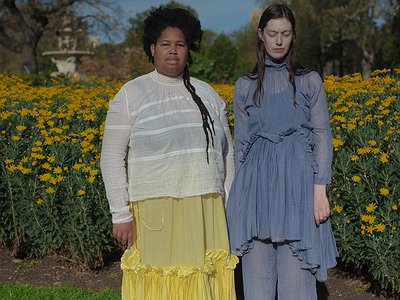Name: Sylvie Nehill (of Divide and Dissolve)
Nationality: Australian
Occupation: Musician
Current Release: Gas Lit on Invada Records
Recommendations: Ai Ogawa – Sin (1986) / Les Filles de Illighadad - Les Filles de Illighadad (2016)
To buy music and learn more about Sylvie and Takiaya visit the Divide and Dissolve website at www.divideanddissolve.com/
When did you start writing/producing music - and what or who were your early passions and influences? What is it about music and/or sound that drew you to it?
I was 16 when I joined my first band. Early influences were Joy Division, Interpol, The Cure. I grew up constantly listening to music and feeling completely engaged and immersed in the experience of actively listening. As soon as I knew the basics of my first instrument (drums), I began to create. When I was a teenager I would adjust every EQ to increase the bass frequencies – I loved the bodily feeling of experiencing sound.
For most artists, originality is first preceded by a phase of learning and, often, emulating others. How would you describe your own development as an artist and the transition towards your own voice? What is the relationship between copying, learning and your own creativity?
Copying and learning from other people is a great way to learn and it's certainly how I developed as a musician. I love witnessing how people form a style or character that is unique to the person holding the instrument. I developed my style through practicing yoga and achieving a bodily balance and strong centre of gravity; down-tuning my drums and increasing the resonance – this gave me more space and time to naturally react; and through touring and playing a bunch of punk shows where I sat directly in front of Takiaya’s guitar and bass stacks without being mic’d, so I had to strike the drums hard and loud.
What were your main compositional- and production-challenges in the beginning and how have they changed over time?
Having enough space (in whatever format – digital, vinyl) to fit all of our sound in. It can be challenging fitting all our elements in when we are so bass heavy. Working with Ruban (Producer of Gas Lit) was wonderful because he made us sound huge.
What was your first studio like? How and for what reasons has your set-up evolved over the years and what are currently some of the most important pieces of gear for you?
Our studio is wherever we are. We set up wherever we live, stay, or play. I’m really excited to have an amazing friend and percussion expert make a drum kit for me this year. I love my UFIP cymbals and my old 60’s Premier Snare drum. I phased out rack-toms early on with Divide and Dissolve and use two floor toms as they achieve more depth and resonance.
How do you make use of technology? In terms of the feedback mechanism between technology and creativity, what do humans excel at, what do machines excel at?
I use a Boss ME-50B and a bass rig to drone the resonance of my drums. I like doing this with my UFIP ride cymbal which has incredible depth but also heaps of singing overtones. I’ve also done this with the snare drum which I tune to vibrate to Takiaya’s guitar.
People are great at setting intentions and technology can help achieve them.
Production tools, from instruments to complex software environments, contribute to the compositional process. How does this manifest itself in your work? Can you describe the co-authorship between yourself and your tools?
The relationship I have to my tools is similar to the one I have with my voice. My instrument is an extension of my body and mind. I think about the drums as being tonal and having a similar range to the voice of a person speaking. There is also a feedback relationship between the instrument and me which is a deeply kinetic one.
Collaborations can take on many forms. What role do they play in your approach and what are your preferred ways of engaging with other creatives through, for example, file sharing, jamming or just talking about ideas?
Takiaya and I collaborate most often through picking up our instruments and playing together, but an important part of this process is also spending a lot of time around each other day to day. A crucial element in our collaborative process is us connecting with our ancestors.
We work with Minori Sanchiz-Fung on each album. When we collaborate we talk about ideas, share any work that might be relevant to the ideas, then eventually send each other files to work with. Minori the only person we have collaborated with and in this way. It’s possible to work this way because of Minori’s incredible talent and a feeling of mutual trust.


